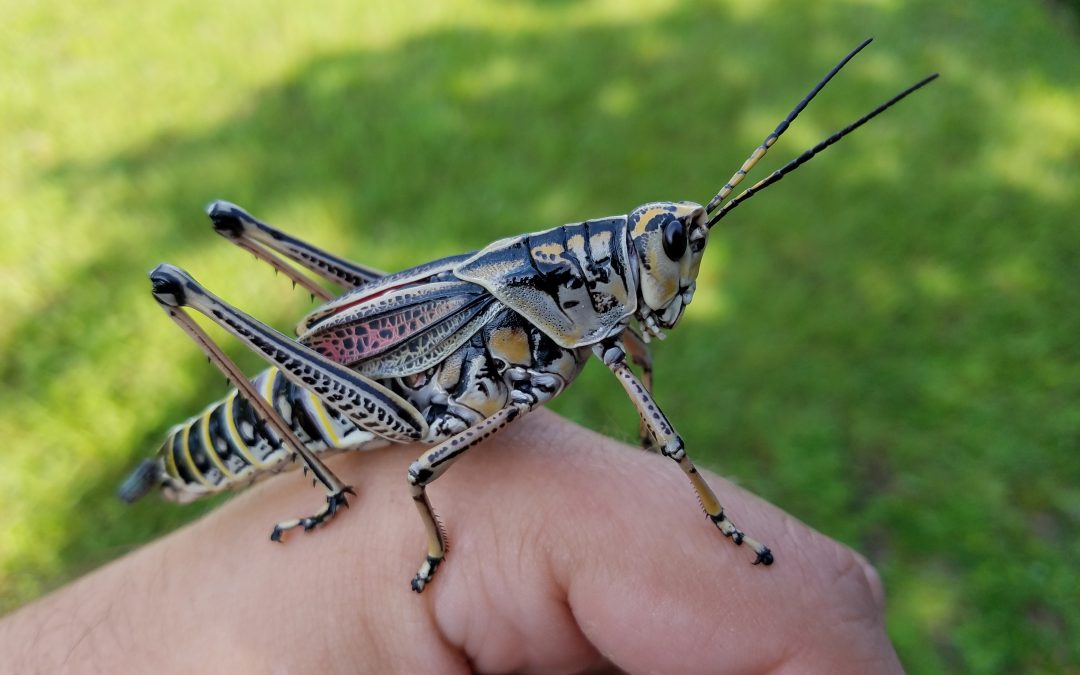
by Evan Anderson | Jun 5, 2025
The Eastern Lubber Grasshopper
From spring to early summer every year, a certain grasshopper can be seen in the Florida panhandle: the eastern lubber, also known as the Georgia thumper. Sometimes emerging in huge numbers, this can be distressing to residents who suddenly find themselves amidst what might appear to be a plague of biblical proportions. Females lay eggs in the soil, and seem to prefer woodland areas with soil that is neither too wet or too dry. With each female laying one or more ‘pods’ of eggs, and each pod containing up to 80 eggs, this can lead to a lot of grasshoppers!
Nymphs are the young and immature form of the grasshopper, and appear different than the adults. Newly hatched lubbers are black with a yellow, orange, or red stripe running down their backs. They range from about ½ inch to 1 ¾ inch long while still in the nymphal stage, and tend to stay together in groups. Adults are seen most often starting in July, growing to a size of up to 3 ½ inches in length. Adults may remain black, but are often seen in lighter colors, from yellow to orange.
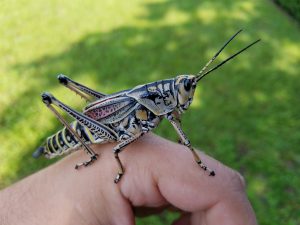
An adult eastern lubber grasshopper.
Eastern lubbers feed on a wide variety of plants. While adults prefer low, wet areas, they will sometimes damage crops or ornamental plants. They eat less than one might expect, given their size, but groups can still defoliate plants if left unchecked. Thankfully, they cannot fly, and therefore do not range over a wide area individually.
If these grasshoppers become a problem in landscapes or gardens, control methods are best undertaken early, while the insects are young. If populations are not great, they can be hand picked and removed. If treatment with insecticide is desired, there are several products available that kill lubbers. For individuals desiring a more ‘natural’ insecticide, products with the active ingredient spinosad are relatively safe to use, if slow acting. Spinosad should be applied in the early morning, late evening, or at night, to avoid affecting foraging pollinators such as bees.
Other insecticides will also work, including those with the active ingredients carbaryl, bifenthrin, cyhalothrin, permethrin, or esfenvalerate. Note that the active ingredient may not be the same as the brand name, and may only be listed in smaller print in the ‘ingredients’ portion of the product’s label. Avoid applying insecticides too close to water bodies, as they may harm fish.
For more information, see the EDIS publication on eastern lubbers at https://edis.ifas.ufl.edu/publication/IN132.
Evan Anderson
Walton County Horticulture Agent
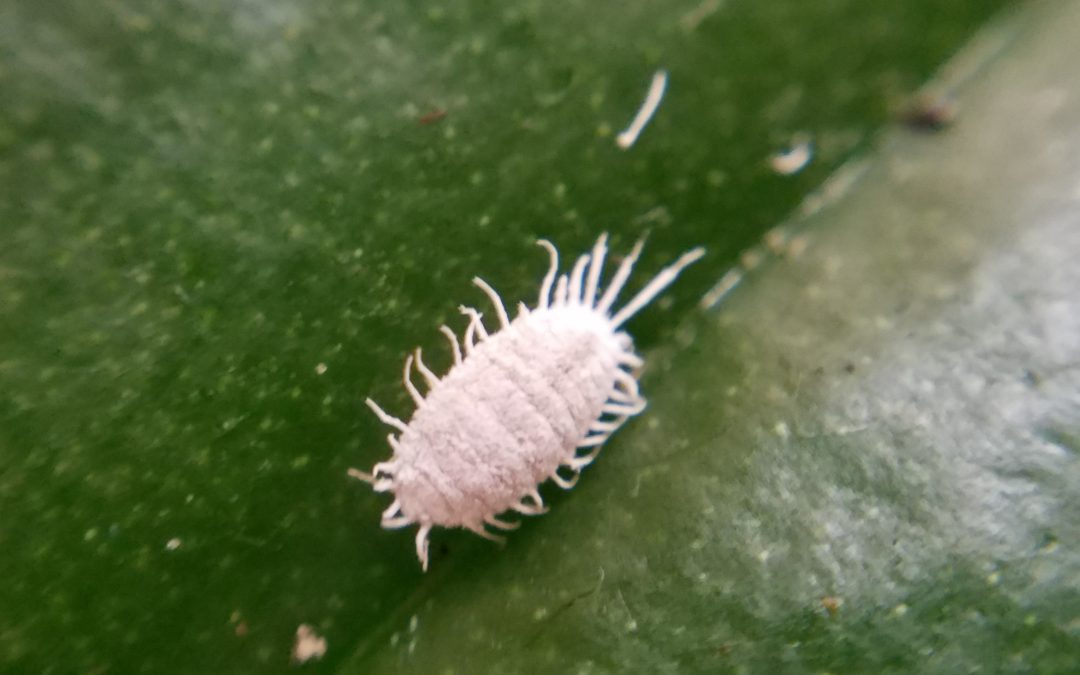
by Evan Anderson | Jun 24, 2021
There are lots of plant pests out there, and it can take a trained eye to tell which one is doing damage. Many of the insect pests that feed on crops and ornamentals have piercing-sucking mouthparts. These insects do not chew on leaves and leave holes behind; instead, they have a long stylus-like mouthpart they use like a straw to suck out plant juices. Over time this can weaken plants, cause irregular growth as damage builds up on new sprouts, introduce diseases to their hosts, and even cause mold to grow on leaves.
Because they drink so much fluid for their meals, many piercing-sucking insects exude a sugary liquid called honeydew. This liquid drops onto stems and leaves below which can leave them shiny and sticky. Eventually, the coating will grow a light greyish coating of sooty mold, which doesn’t do much harm to the plants itself but is a good indicator that you have an insect problem. You may also notice ants on your plants, working to harvest the honeydew for food. The ants don’t harm the plant, but following are some of the pests that do:
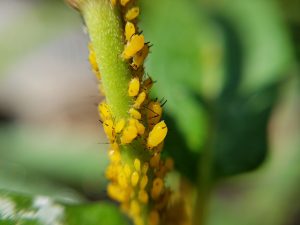
Aphids feeding on a plant stem.
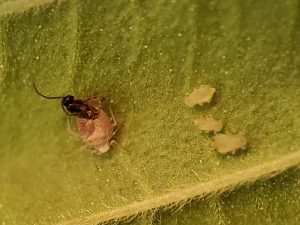
A parasitic wasp emerging from a dead aphid.
Aphids – Found on a wide variety of plants, aphids are fat-bodied little insects that often focus on new, tender growth. Their color depends on the plant they’re feeding on, and they can breed explosively. A female aphid does not need to mate to produce offspring, so a one can produce a lot of children very quickly. Look closely and you might be able to see their cornicles, which look like little tailpipes; these can help identify these pests. Luckily, we have some help in controlling aphids, as they are often parasitized by wasps. If you see large, swollen, brown aphids present, you probably have some wasps working for you.
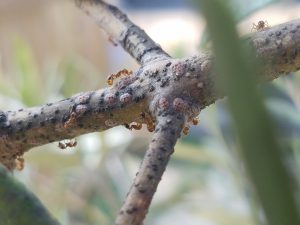
Ants tending some scale insects on a stem.
Scale Insects – Sometimes appearing to just be a bump on a stem or leaf, scale insects don’t move once they pick a plant to live on. Prolific producers of honeydew, some species grow a waxy shell which can protect them and make them difficult to deal with.
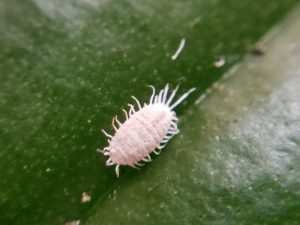
A mealybug.
Mealybugs – If you spy something white and fluffy living on stems or leaves, you might have mealybugs. Soft-bodied insects that are related to scales, they don’t move much. They feed on a wide range of host plants, but can effectively be controlled with a variety of methods once they’re found.
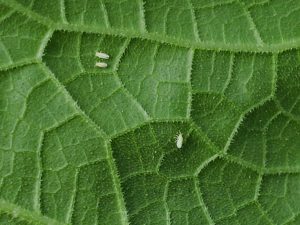
Whiteflies on the underside of a leaf.
Whiteflies – Not true flies, they are truly white in color. Tiny little members of the order Hemiptera (the same order that includes, aphids, scales, and mealybugs), they hang around the undersides of leaves. They enjoy warm weather and can become a problem in greenhouses. They are a bit more difficult to control than some of the other pests listed here.
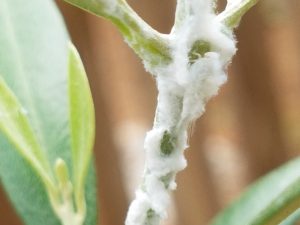
A psyllid nymph hiding in its waxy coating.
Psyllids and planthoppers – Small jumping insects that affect a variety of plant species, some are responsible for transmitting important plant diseases. Pierce’s disease of grapes and citrus greening, for example, are both vectored by these critters. Young nymphs sometimes secrete a waxy coating which may make them look similar to mealybugs.
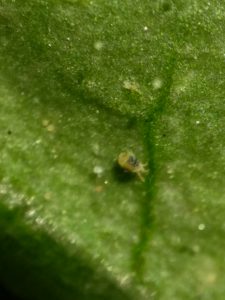
A tiny two-spotted spider mite.
Spider Mites – Not an insect but an arachnid, spider mites love hot, dry weather. Almost microscopic in size, the damage they do to leaves is often the first sign that they are present. Looking closely, one might notice tiny webbing where the mites live, or even the mites themselves on the undersides of leaves and on stems.
Many of these pests can be treated with a combination of methods. A sharp jet of water can dislodge some, hand removal can reduce populations even more, and products such as insecticidal soap or horticultural oils can finish them off. Insecticidal soaps are best used on soft-bodied insects such as aphids or mealybugs, while oils such as neem can help suffocate hard scales. Use products such as horticultural oil in the evening during hot weather to avoid damaging plant tissues with intense sunlight. Thorough coverage is important, as these products only control the pests they contact.
For more information on controlling insects, see our EDIS publications, such as Insect Management in the Home Garden or Landscape Integrated Pest Management.
by Evan Anderson | Oct 14, 2020
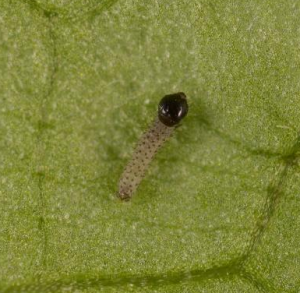
A newly hatched armyworm –photo by Lyle Buss
With a population that never seems to quite disappear in North Florida, the armyworm is a caterpillar pest of many plants. There are four types found in our area: fall, southern, yellow-striped, and beet armyworms. The caterpillars pupate into moths, which breed roughly from April to December, but warmer weather may lead to them being sighted even in the middle of winter. Adult moths, which are relatively nondescript and gray-brown in appearance, lay masses of 100-200 eggs on plants. Young armyworms are tiny and very difficult to detect, often hiding during the brightest parts of the day.
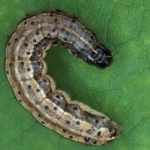
A fall armyworm. –photo by J L Castner
The armyworm grows to a length of about 1 ¼ inches, taking about two weeks to reach its full size. The caterpillar builds a cocoon in the soil and pupates into a moth, living another one to three weeks. With its ability to eat a broad range of plants, this can lead to large populations of these insects in a relatively short time.
Armyworms seem to prefer eating grasses (especially Bermudagrass in lawns), but will chew on almost anything in their path. They have been observed eating citrus trees, tobacco, cotton, strawberries, and even weeds like pigweed and nutsedge. A hungry armyworm might even turn on its fellow caterpillars, eating them as well if they are too close. When large numbers of these pests are present, the damage they do to surrounding foliage can be stark. Young caterpillars may skeletonize leaves, while older larvae will make holes in leaves or defoliate plants fully.
Years with an abundance of wet or humid weather seem to help armyworms reproduce. Armyworms seem to be attracted to newly established turf, and heavy fertilization of turfgrass in late summer can also cause populations to build. Scout for them
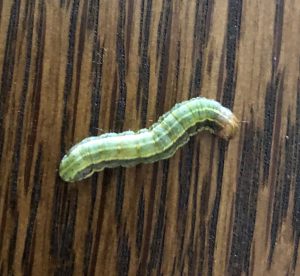
A beet armyworm. –photo by Serena Robison
during cooler hours of the day, or when it is overcast or rainy. Mixing a tablespoon of dishwashing soap in a gallon of water and pouring it over a four-square foot area will cause insects to crawl to the surface – do this if damage is present and armyworms are suspected. For lawns, treatment at the first sight of damage may help, though a lawn may very well survive an attack by armyworms. If chemical control is necessary, there are numerous options. Products containing the active ingredients Bacillus thuringiensis, acephate, bifenthrin, carbaryl, permethrin, spinosad, and others have all been labeled for use on armyworms.
For more information, see our EDIS publication on fall armyworm at https://edis.ifas.ufl.edu/in255 or contact your local Extension office.
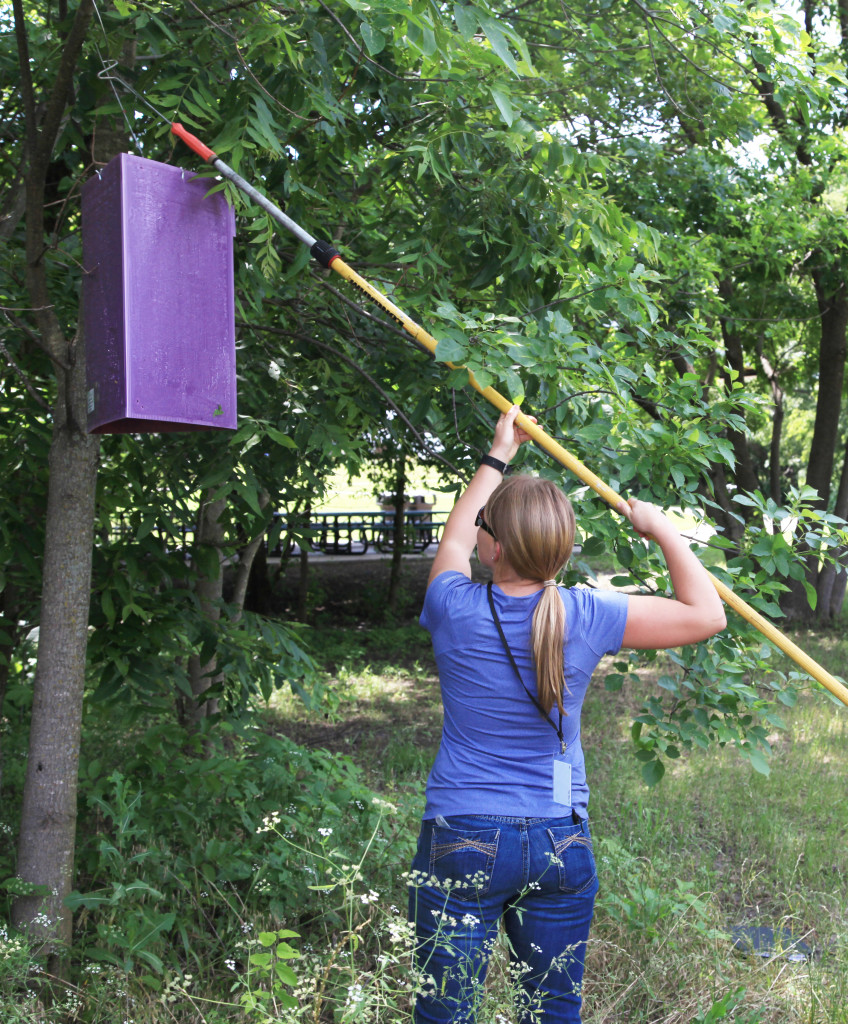
by Matt Lollar | May 24, 2016
From time to time I am reminded of how little I know. Honestly, I am reminded on a daily basis. A few weeks ago someone asked me about the purple things hanging from the trees. Luckily, the person gave me some good southern directions on where I could find one of these things hanging around in Marianna. So I drove out to the site to get a better look. What I saw hanging in the tree was a three-sided, purple triangle about two feet tall and a foot wide. It looked to me like someone got a box kite stuck in a tree. Upon further research, it was determined this box kite like thing was a monitoring trap for the emerald ash borer (EAB).
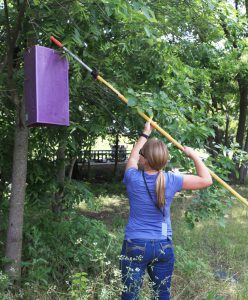
A woman hanging an emerald ash borer trap in a tree. Photo Credit: Texas A&M University
The emerald ash borer (EAB) is a destructive, exotic wood-boring beetle native to Asia. It was first discovered in North America in July 2002 and has made a home in Michigan, Ohio and Ontario, Canada. Millions of ash trees have been killed by the EAB in Michigan and invested ash tree nursery stock in other states indicates the potential for increased spread of the pest. EAB has made its way to the south and has been found in Louisiana and Arkansas.
Monitoring traps are not the only means of EAB detection. A proactive approach utilizing observant citizens can help keep an eye out for potential populations. You can use these tips to monitor your community for emerald ash borers:
Ash Tree Identification – Ash trees are identified by their (1) opposite branching pattern, (2) compound leaves with 5-9 leaflets, and (3) diamond shaped bark ridges on mature trees.
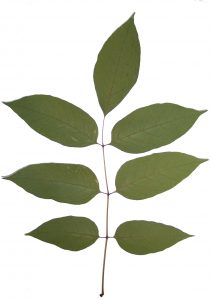
A compound leaf of an ash tree. Photo Credit: FDACS
Woodpecker Damage – Of course, not all woodpecker damage on ash trees is associated with EAB infestation, but woodpecker damage in the upper part of the tree can indicate their presence. The woodpecker damage is usually accompanied by vertical cracks in the bark.
Canopy Thinning – As the attack progresses, bark cracking continues and the canopy in the upper half of the tree begins to thin.
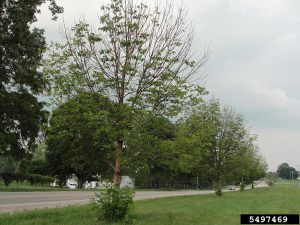
Michigan ash tree showing decline due to Emerald ash borer. Photo Credit: USDA
Tunnels and Holes – The emerald ash borer makes distinctive S-shaped tunnels that differ from damage from other borers.
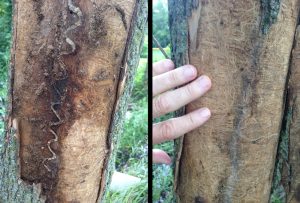
EAB Damage (left) VS Other Borer Damage (right). Photo Credit: Texas A&M University
This beetle hitchhikes on firewood and infests new areas at an alarming rate. Although the EAB has not yet been detected in Florida, transporting firewood from other states puts Florida ash trees at risk. Your help is needed to detect possible infestations so they can be quickly eradicated. The information available at the following links will help you identify the EAB, EAB host trees, and infestation symptoms.


















